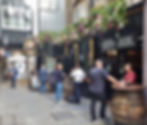Old Dr Butler's Head: City pub named for James I's physician
- London On The Ground
- Aug 19, 2022
- 3 min read
Updated: Sep 9, 2022
The pub is named after a self-proclaimed specialist in nervous disorders, who had no medical degree.

According to its website a pub was first established on the site in Mason's Avenue, a narrow alley near Moorgate in the City of London, in 1610. The website also claims that the present building dates from just after the Great Fire of London of 1666, although other sources say it was built in the early 19th century.
Walks available for booking
For a schedule of forthcoming London On The Ground guided walks, please click here.
Regardless of exactly when it was built, it is an old style pub with plenty of dark wooden panelling and a range of Shepherd Neame and other cask ales. It also offers traditional pub grub and a function room.
William Butler, for whom the pub is named, was born in Ipswich in 1535 and attended Peterhouse, the oldest college of Cambridge University. He was later elected a Fellow of Clare Hall, Cambridge (which changed its name to Clare College in 1856). As an undergraduate he was a sizar, a student who had financial assistance for their studies in exchange for performing menial tasks in their college.
Although an educated man, his degree was not in a medical subject. Nevertheless, the university granted him a licence to practice 'physic' (what we would now call 'medicine'). He went on to gain a strong reputation in this field and was appointed by James I as a court physician.

However, his chief passion seems to have been drinking in taverns. The 17th century writer John Aubrey said that Butler lived in an apothecary's shop with a maid whose main role was to make sure he got home each night.
His eccentric methods started to attract a certain renown after he brought a clergyman around from an opium-induced coma (presumably the job brought pressures). His technique was to put the comatose cleric inside the still warm chest cavity of a recently slaughtered cow.
As a court physician, Dr Butler treated the Prince of Wales, Henry Frederick, eldest son of King James and his wife Anne of Denmark, in 1612. However, the doctor was unable to save the prince, who died of typhoid at the age of 18 and was widely mourned. Henry Frederick's younger brother Charles succeeded him as Prince of Wales and later became King Charles I, only to lose the Civil War and his head to Parliamentary forces.
Butler's practice was based on what he considered to be reasoning and experience, rather than any well established theory. However, given that established treatments at the time included blood-letting and administering dangerous chemicals, his cures may not have been any worse for patients than those of other physicians.
He was known to conduct consultations on London Bridge, in the days when it had houses along its length, and suddenly drop his unsuspecting patient through a trap door into the raging waters below. It is not clear what ailment this was designed to cure.
Another treatment was to fire pistols behind the ears of epilepsy patients to scare the condition out of them. His cure for bubonic plague, outbreaks of which were then common, was to plunge the infected person into cold water.
The good doctor is said to have developed Dr Butler's Purging Ale, a medicinal drink for gastric ailments (presumably he came up with this idea while pursuing his own favourite pastime). This proprietary brew was only available at the taverns he owned and which displayed Dr Butler's head on their signs.

Whatever the effect of his remedies on his patients, Dr Butler's own health was clearly robust. He died in around 1618 at the age of 83, a very long lifespan in those days.
He was buried in Cambridge's church of St Mary the Great, the university church, where the funeral service of Stephen Hawking took place some 400 years later (while Butler may have been a quack at physic, Hawking was the genuine article when it came to physics).
Today, the Old Dr Butler's Head on Mason's Avenue is the only pub that still displays the doctor's likeness and his name. Sadly, his Purging Ale is no longer on the drinks list, but a visit to his pub is nonetheless recommended.

Walks available for booking
For a schedule of forthcoming London On The Ground guided walks, please click here.
